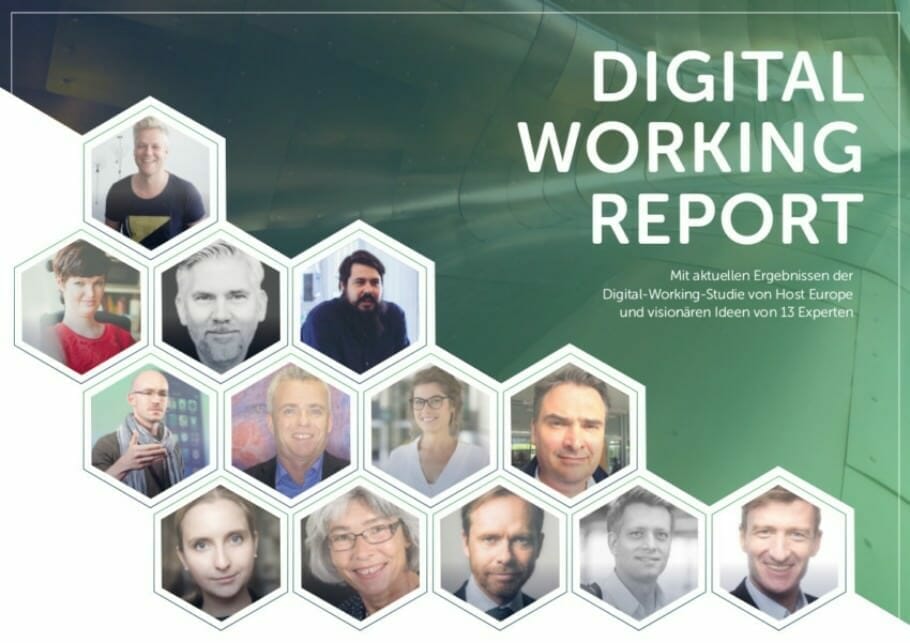Your shopping cart is currently empty!
For their successful, good life Information you really need: Government-funded publisher, awarded the Global Business Award as Publisher of the Year: Books, Magazine, eCourses, data-driven AI-Services. Print and online publications as well as the latest technology go hand in hand - with over 20 years of experience, partners like this Federal Ministry of Education, customers like Samsung, DELL, Telekom or universities. behind it Simone Janson, German Top 10 blogger, referenced in ARD, FAZ, ZEIT, WELT, Wikipedia.
Disclosure & Copyright: Image rights held by Host Europe. Web hosting provider Host Europe supports our work with free web hosting.
Digitization of the working world in German companies: frightening status quo {Trend! study}
By Simone Janson (More) • Last updated on October 07.02.2017, XNUMX • First published on 07.02.2017/XNUMX/XNUMX • So far 8497 readers, 2683 social media shares Likes & Reviews (5 / 5) • Read & write comments
The digitization of our Working world is currently one of the most discussed topics in the HR scene, in Companys, at trade fairs, conferences and events. Because it presents companies with fundamental structural challenges. But what is the current state of affairs? A study by Host Europe and YouGov provides the answer.

How digital transformation is changing the world of work
Digital change is not easy for German companies, but it is Executives like Employees faced with crucial challenges: the bosses and managers have to relinquish power because networked work requires completely new structures. And the employees have to take responsibility and themselves to organize.
Teams work across national boundaries and time zones, staggered in time, using cloud services that are accessible from anywhere. This way of working is completely beyond the control of bosses, who were used to the fact that their employees of 9-17 clock were practically tangible before their nose. And also many employees in the self-organization of their work unsettled.
What is the status quo in Germany?
Therefore, digital work in German companies is not always at the level that is publicized to the outside world: Many a company that I know has made the topic of digitization a big priority, and is even active in an advisory capacity in this area - but solves internally the question of how often an employee is allowed to work from home, fierce power struggles and fear of loss (in relation to Control) out.
So how is the state of digitalization in Germany actually? Answers and inspiration are provided by the current one Digital Working report. To this end, Host Europe, in cooperation with YouGov, surveyed 1.000 employees and created an inventory of the digitization of German office workplaces. The report also contains visionaries ideas by 13 pioneers from different disciplines who bring their individual vision to the Future work.
Exciting models
The model of the trust-based workplace and trust-based working hours, for example, is exciting, as practiced by Microsoft Germany and which is bindingly recorded in a sales agreement. Anna-Lena Müller, Communications Manager Digital Transformation at Microsoft Germany, describes the model as follows:
“Each employee decides for himself when and from where he works: In Office , from home or in the cafe. It's not the attendance that counts, it's the result. We have also been showing in our new company headquarters in SchwaBING since October
2016 employees, partners, customers and interested parties how we imagine working in an office today and in the future. The fact that not all employees have a fixed seat in the new company headquarters and that not all find a place at the same time contributes to the developments of the new Welt of working on account. "
Positive Approaches
And there are more examples: Stefan Pfeiffer, responsible for Marketing Collaboration and Workforce Solutions at IBM Germany reports on the work of a networked project manager, the purely digital physical Meetings makes superfluous. For Dr. Claus Boyens, Managing Director of Host Europe GmbH, is creating “Digital Convenience”, a clear Defined digitization strategy with well thought-out toolselection, the core task of corporate management. And Dr. Peter Geissler, Head of Digital Workplace at Communardo Software GmbH, describes the use of digital helpers, so-called bots, in their knowledge work:
Business Intelligence evaluates data around the clock, prepares it graphically and gives us recommendations and Orientation, which was previously considered the special expertise of colleagues.
The naked figures speak a different language
That all sounds great, simple and extremely advanced - if only there weren't the ugly numbers. Unfortunately, they speak a completely different language when it comes to the digitization process in companies. Digitization often suffers from employee acceptance: 45 percent of those surveyed want some Tasks simply do not do it digitally, 22 percent are hindered by legal regulations and 16 percent even by the technical equipment.
According to the study, the average Workplace a landline phone (83 percent), writing materials and office supplies such as paper and pens (73 percent) and a stationary computer (68 percent) and Internet connection via LAN (51 percent). A fax machine (49 percent) is still much more common than laptops, smartphones, tablets or equipment for video conferences.
Home office better equipped than office
This can then be found with many employees in the home office, where the employees are in some cases much better equipped than at their employer: Here, laptop, smartphone and
WiFi for basic equipment. Tablet, access to cloud storage and headset as well as webcam for video telephony are also more likely to be found in the home office than at an office workstation.
This aspect is particularly exciting for me Privacy and data security – after all, that's why I recently got mine eMails, address and calendar data has been moved to its own server at Host Europe with host exchange connection.
Privacy with weaknesses
The study now reveals that the IT-Security leaves a lot to be desired, especially in mobile and home offices. After all, 70 percent of those surveyed state that their workplace in the office is protected with an up-to-date antivirus program and their mailbox with a spam filter; in the home office it is 75 percent.
However, only 56 percent of work data – regardless of whether it is an office or home office – is backed up. 64 percent have no password protection for their mobile devices. Mobile end devices are not equipped with antivirus software in 71 percent of cases. And only a minority of 25 or 23 percent avoids risky things Behavior, turning off Personal Hotspot and Bluetooth connectivity when not needed and disabling automatic reconnection to public Wi-Fi networks.
Conclusion: Frightening
Overall, the Digital Working Report shows very clearly that there is still a lot of catching up to do in terms of digitization in German companies - be it in terms of the technical equipment in the offices or on mobile workstations, but also in terms of the corporate culture and the mindset of executives and employees concerns.
That the Status Quo is technically at such a low level in many companies right now, frightened me personally. There is still a lot to do for the digital pioneers.
Here writes for you
 Simone Janson is publisher, Consultant and one of the 10 most important German bloggers Blogger Relevance Index. She is also head of the Institute's job pictures Yourweb, with which she donates money for sustainable projects. According to ZEIT owns her trademarked blog Best of HR – Berufebilder.de® to the most important blogs for careers, professions and the world of work. More about her im Career. All texts by Simone Janson.
Simone Janson is publisher, Consultant and one of the 10 most important German bloggers Blogger Relevance Index. She is also head of the Institute's job pictures Yourweb, with which she donates money for sustainable projects. According to ZEIT owns her trademarked blog Best of HR – Berufebilder.de® to the most important blogs for careers, professions and the world of work. More about her im Career. All texts by Simone Janson.
7 answers to "Digitization of the working world in German companies: frightening status quo {trend! study}"
-
I think the state of things is somewhat underestimated. Digitization conquers our lives often in the form of mobile apps. There is even already an app for works councils of IFB https://www.ifb.de/betriebsrat/service-ifb-app.html, which also allows the works council members access to a labor law database.
-
Thanks for the note, that is exciting. I think, however, that the digitization in important points still lagging behind, but I will look at the app but.
-
-
Digitization of the working world in German companies: study shows frightening status quo - Recommended contribution ZnM5du2cuX
-
Digitization of the world of work in German companies: Study shows frightening status quo - - Recommended contribution tBC6BB1Uyt @Berufebilder
-
Digitalization of the working world in German companies: study shows frightening ... via BERUFEBILDER - Recommended contribution 5WCIPPQoNB
-
Digitalization of the working world in German companies: study shows frightening ... via BERUFEBILDER - Recommended contribution Ia6vweM6Mo
-
Digitization of the working world in German companies: study shows frightening status quo by Simone Janson - Recommended contribution n0a3VEE2X7

![Career planning for career entry & transfer: How to find the best consultant [+ checklist] Career planning for career entry & transfer: How to find the best consultant [+ checklist]](https://e68zy2pxt2x.exactdn.com/wp-content/uploads/2018/wahl-choice-right-stift.jpg?strip=all&lossy=1&ssl=1)






Post a Comment